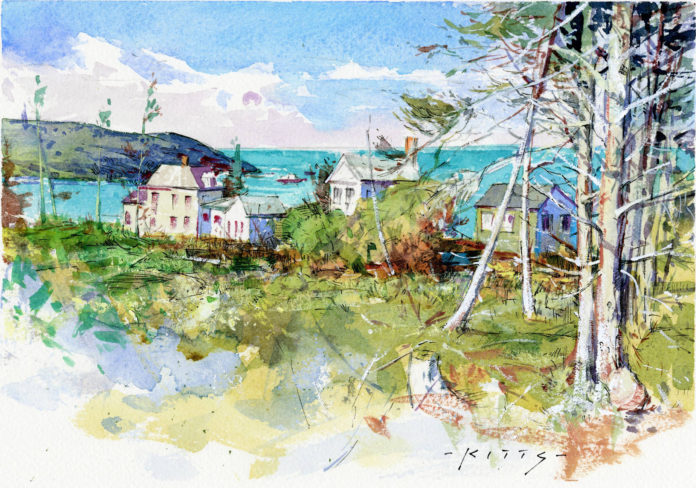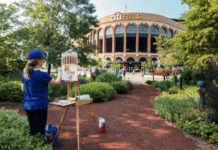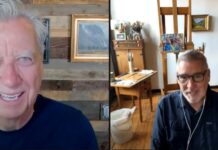Follow along as I share a record of the five days I spent plein air painting on Monhegan Island, walking aimlessly and stopping only when inspiration struck to draw or paint.
Plein Air Painting Without Purpose
by Thomas Jefferson Kitts
thomaskitts.com
One October, I did something I rarely do. I booked two plein air events almost back-to-back — one on Cape Ann, above Boston, and the other in San Angelo, Texas, with one week in between. Although I enjoy these types of competitions, where I can paint a lot of work within a short period, there are times I want to jump off the merry-go-round and be less mercenary. Why? Because art is not about producing product on demand. At its finest, it is about capturing life as directly as possible, and sometimes I lose sight of that.
I decided to refresh myself between my trips to Cape Ann and San Angelo by visiting Monhegan Island. The tourist season would be over, and I could paint for five days without an agenda. Alone. I could walk around and serendipitously discover subjects to paint — like I did back in the day.
MONDAY ARRIVAL — STORM ON ITS WAY
Morning: I take the ferry out of Port Clyde, Maine, motoring out from under the sun into a low layer of clouds along the horizon. By the time we dock, it is clear a storm is close. I meet my host, Alison Hill, who lives and paints en plein air on the island year-round, and she shows me to my room — a tiny garret on the second floor overlooking Lobster Cove. She says we are near Jamie Wyeth’s house (built by Rockwell Kent), but that I won’t run into Jamie since he is currently “in-shore” — the term year-rounders use to describe when someone’s gone to the mainland. Old-time Monhegans might even say, “He has gone to America.”
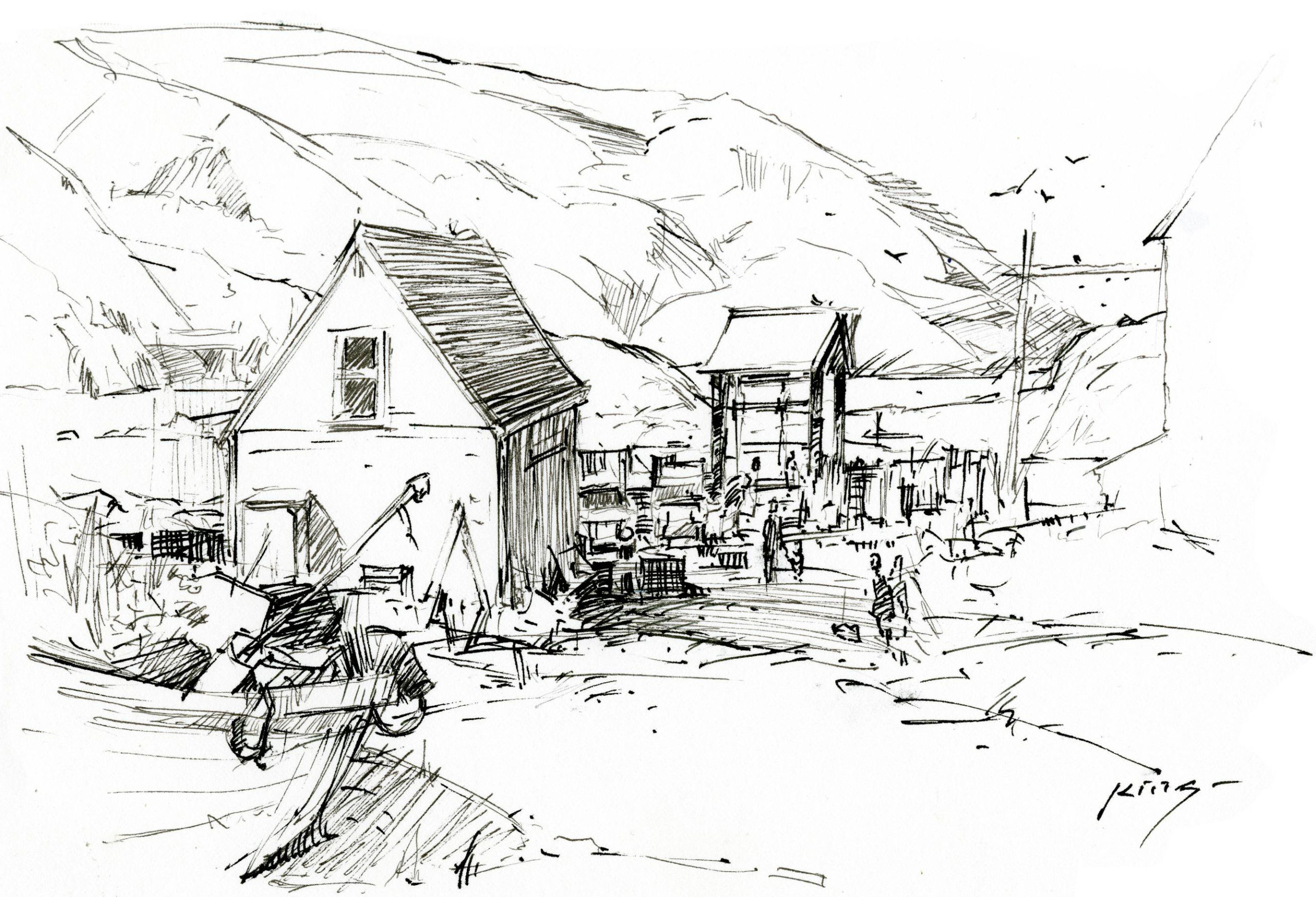
Midday: Aware of the approaching storm, I don rain gear, grab a sketchbook, and rush down to the village. On Monhegan, you walk everywhere, as there are no paved roads, and visitors’ cars are not allowed. My host is one of the few islanders who has a pickup, and she tells me she only fills the tank once a year.
I turn left at the dock, into the wind, and walk along the shore onto a stone breakwater. I see paintings everywhere I turn. There is an old art maxim that says clichés do not arise from your subject matter, they come from you, the artist. Even so, it may be hard to avoid the obvious here.
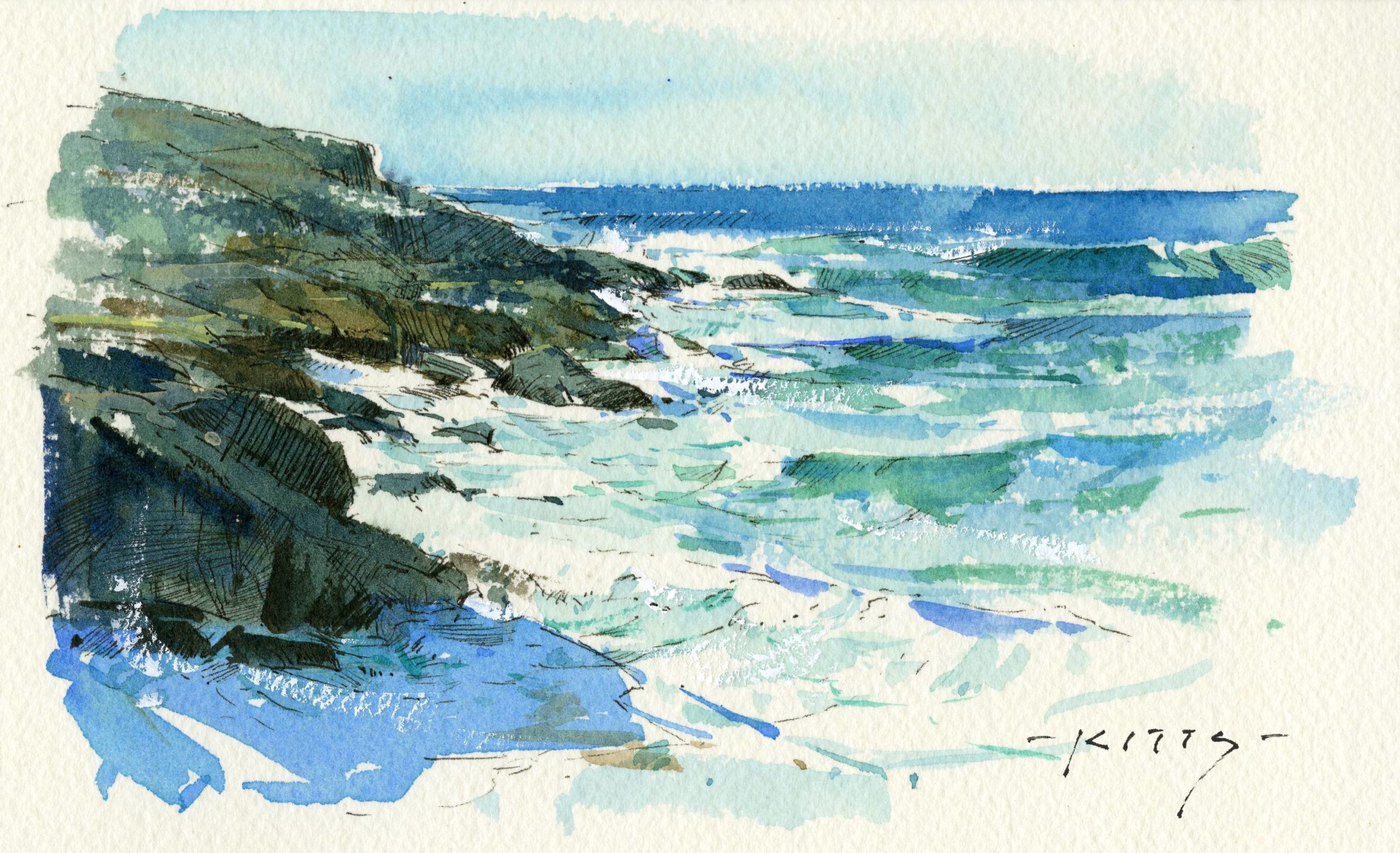
I stop to ink a few vignettes, but eventually conditions grow so foul I have to quit. I head up the hill, making note of places I can paint under shelter, and arrive at the house just as the storm becomes serious. With wind and rain beating at the windows, Alison invites me into her studio to view her work, and we talk art over a few glasses of wine. A fine outdoor painter, she’s well-informed, practiced, and after 17 years of living here, knows Monhegan intimately. We agree to meet the following afternoon and venture out to the back side of the island for a day of plein air painting.
TUESDAY — SUNNY, WITH HIGH WINDS EXPECTED
Morning: I wake up to sunlight pouring into my room. From my breakfast table, I have a fine view to the south and can see chop on the water, indicating a brisk wind. As a plein air painter, I’ll choose rain over wind, but I take what I get. The temperatures today will be in the mid 40s, but the wind will make it feel like the low 30s. It’s a good thing I brought my modified Aldro Hibbard mitts — thick wool socks with holes cut in them to insert a brush.
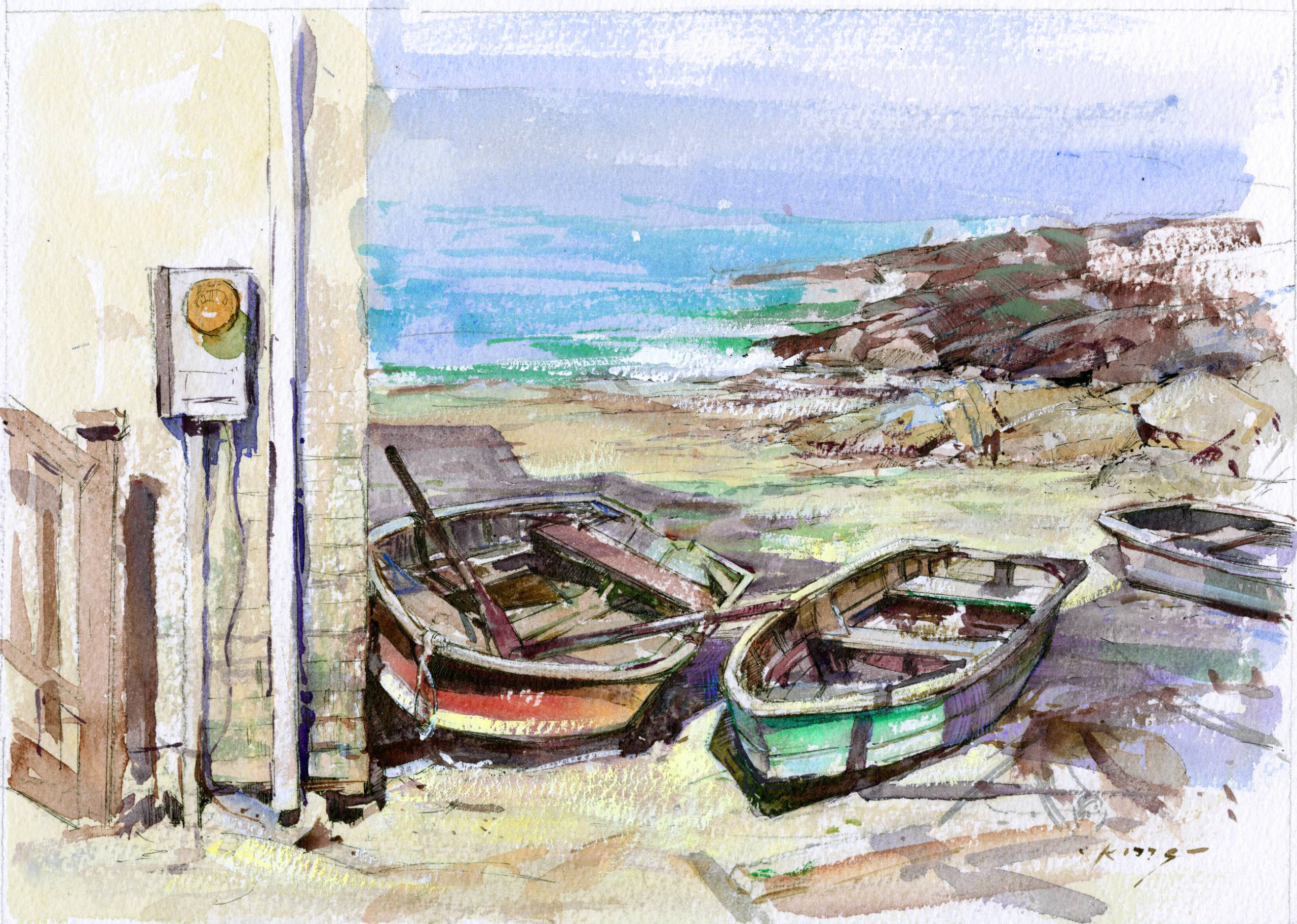
Midday: I’ve been out and about, touring the village in brilliant sun, coming at it along the shore. All who paint here talk about the light, and what they say is true. When the sun is out, everything sparkles and vibrates. Light bounces in from every direction. I think this is because Monhegan is a small island and all of it is near the shore. When the light bounces off the water, it fills the shadows in a way that doesn’t happen inland. I decide to paint a few skiffs scattered in front of some fishing shacks because I am entranced by the pattern of light and shadow, and the splintery curves of the boats.
After making a decent effort, I walk back for lunch and wait for Alison, who will take me to Gull Cove, her favorite place to paint on the Backside — a wild and capricious place of ankle-snapping missteps, high cliffs, and low granite ledges that push out into the surf. Around here, it is crucial to keep an eye on the water at all times. Few people washed off these rocks have ever survived.
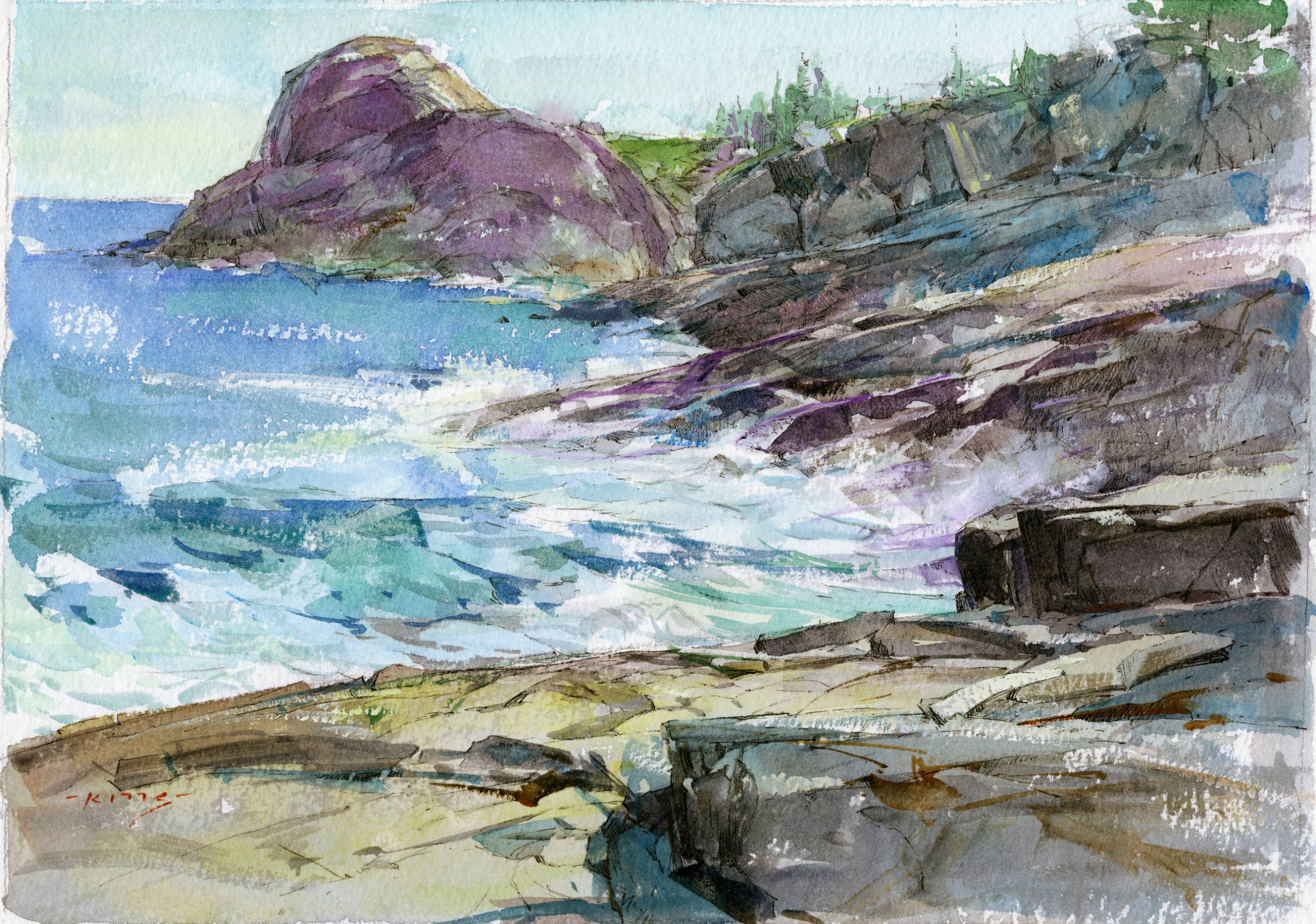
The sun is barely above Gull Point as we set up to paint, and it drops fast, so I must rush to capture the backlit scene on paper. Adding to the challenge is my desire to capture the energy of the waves without being too literal. As Andrew Wyeth once said, “It’s a moment I am after — a fleeting moment, but not a frozen moment.” To me, that is the essence of plein air painting.
After finishing, Alison and I work our way north to the top of Whitehead, the second-highest point on the island. Its glorious view tempts us to paint, but the sun is low, and we must pass through Cathedral Woods before nightfall. This becomes the rhythm of my week: Get up before dawn, go out to paint, and return to shelter before dark — a pattern dictated by nature.
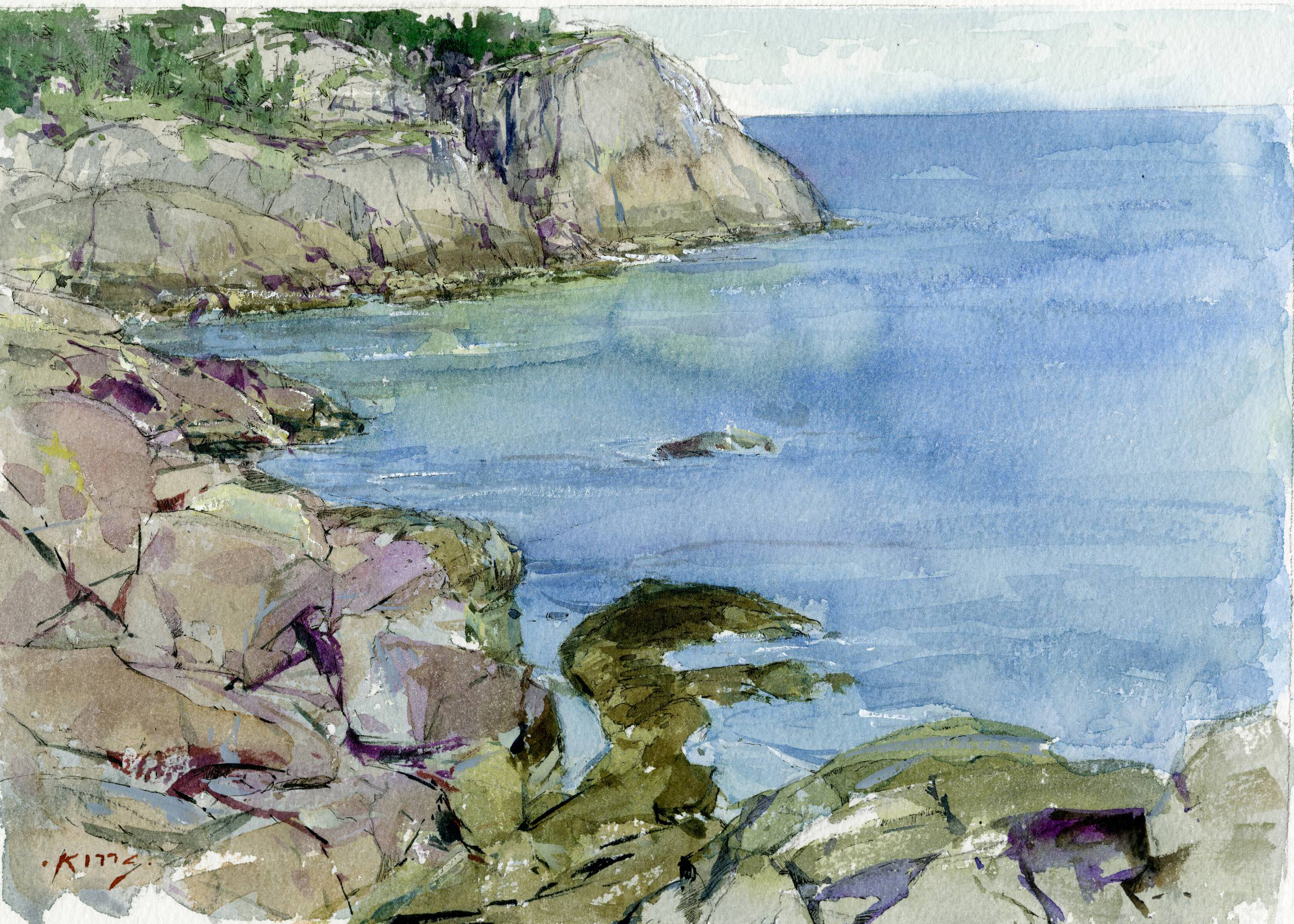
WEDNESDAY — MIXED OVERCAST AND SUN, WITH STORM EXPECTED
Morning: When I am away on a painting trip, it can be a thrill to look at my watch and see that the date should be advanced, and then realize it has been that way for days. Today I will paint and draw the shipwreck near Lobster Cove.
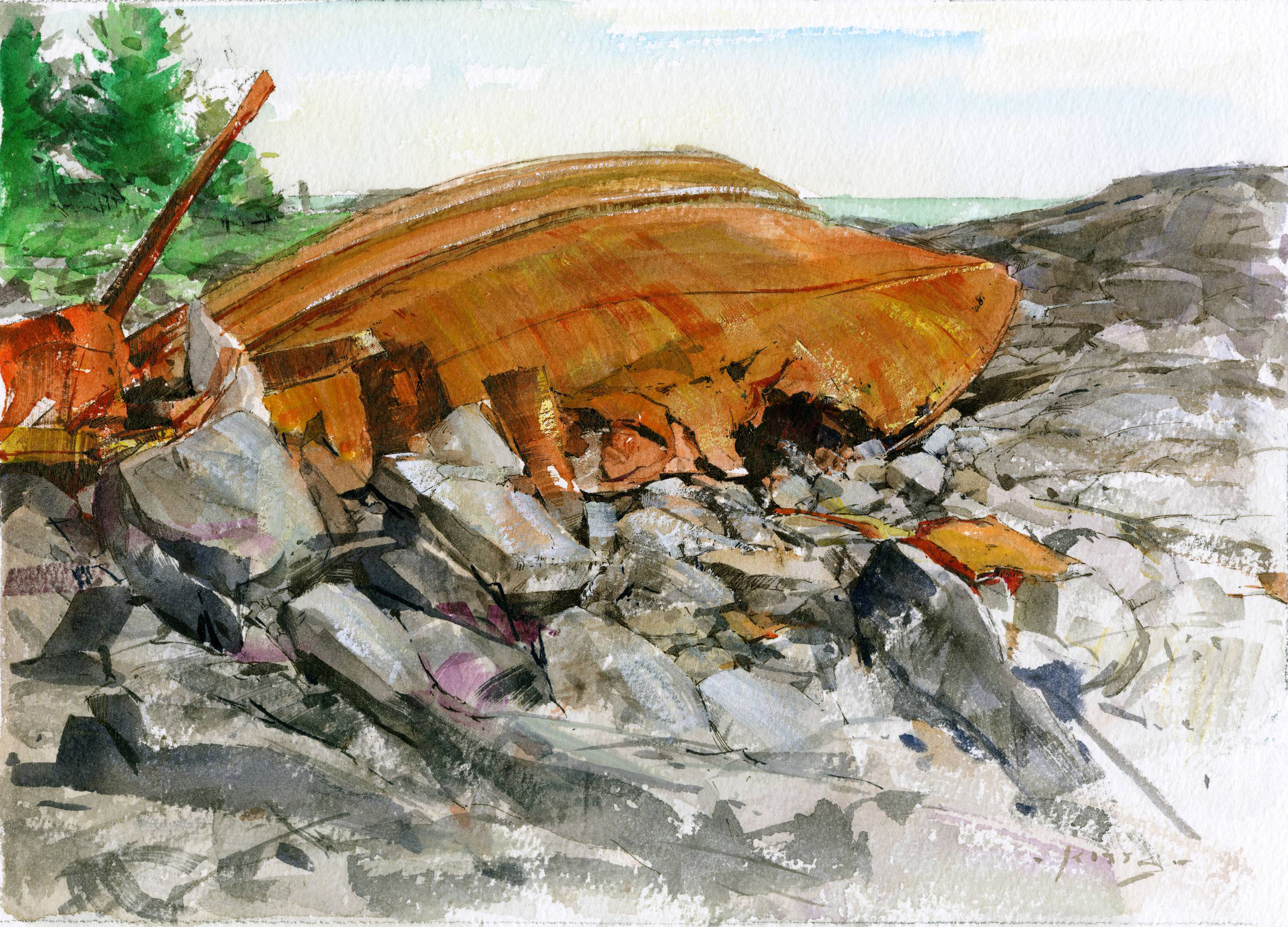
Evening: After finishing the wreck, and drawing a few sketches around it, I walk back to the village to pay my tab at the store. (If the door is unlocked and the owner isn’t there, you log what you take in a notebook and come back later to settle up.) Stepping out, I decide to paint the lighthouse up the hill. With my evening’s dinner in hand (Italian sausage, capers, spinach, and linguini, with a rustic red), I rush to the top and set up in glorious orange light with about an hour of daylight left to paint.
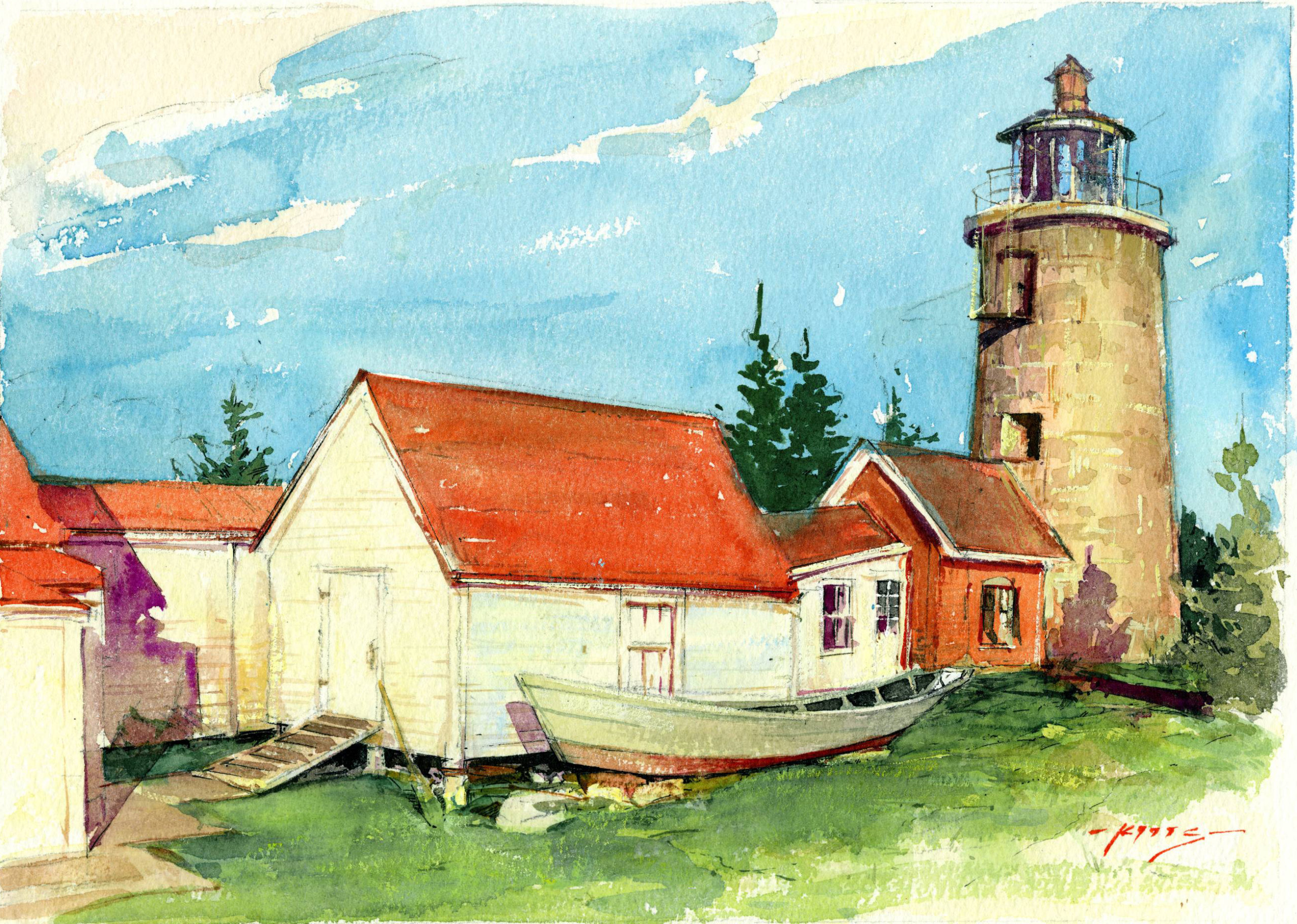
I get a solid start on my sketch before the light snaps off and I turn around to see another storm on the horizon. I jam my easel and paints into my pack and race back down the hill, stopping only to pet Chaco, the village dog who hangs out by the store, before continuing on to the house, hoping to beat the approaching rain. As I peel off my rain gear, I think, “Geez, when will I get another chance to see a nor’easter blow over this island?” I pull my slicker back on and run back down to the Cove, where the show of water and light is epic, absolutely Turner-esque.
THURSDAY — PLEIN AIR PAINTING WITH BLUE SKIES AND WITH HIGH WINDS
Morning: There is a stark contrast between the slow pace of the year-rounders and Monhegan’s abruptly changing weather. Today will bring 40-plus mph winds, and over the rim of my coffee cup I can see giant breakers rolling in from the southeast. I think I’ll hike over to the leeward side of the island and look for fairy houses in Cathedral Woods along the way.
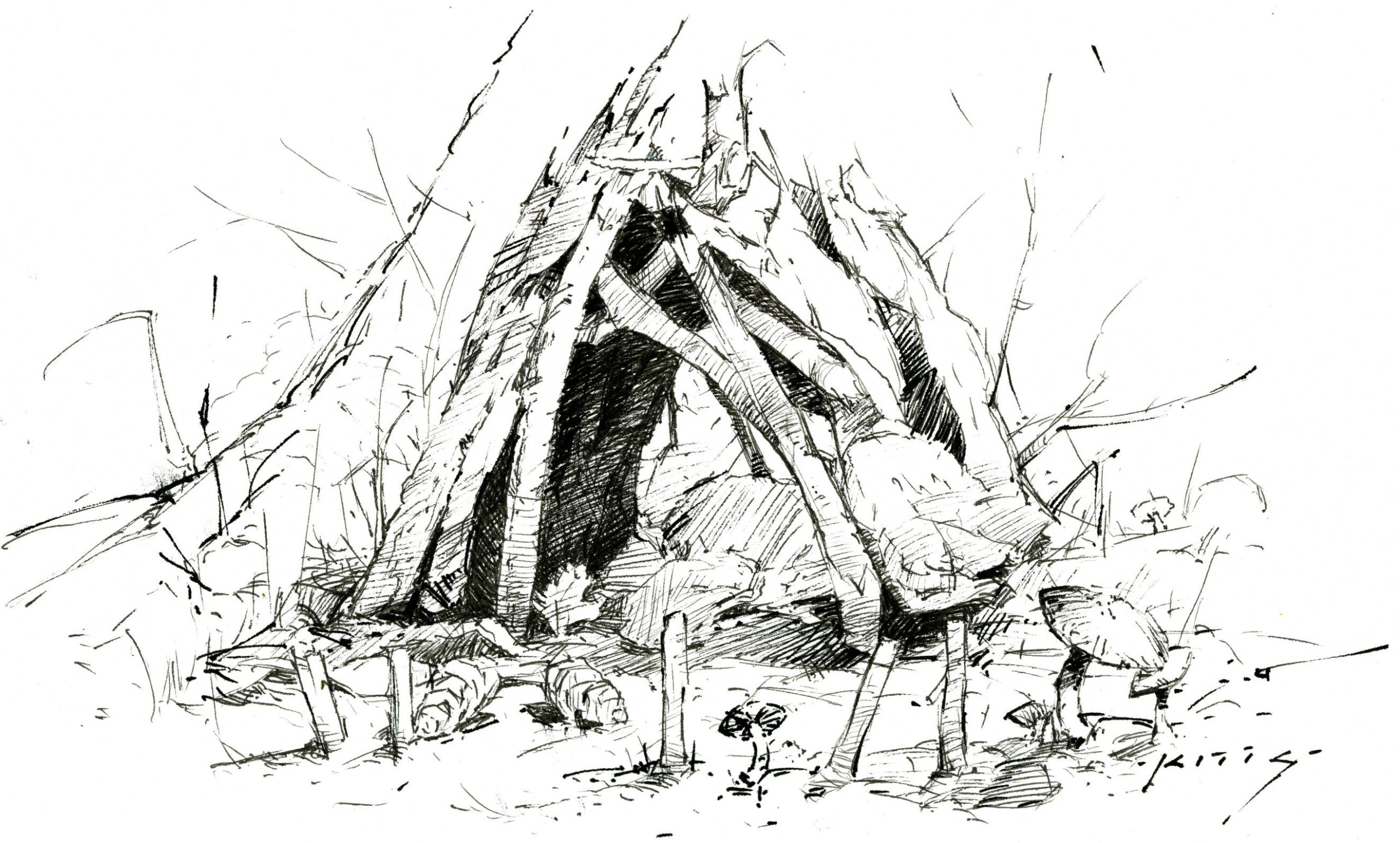
Built by mainland visitors out of twigs, leaves, moss, and shells, some of the houses can be quite elaborate. Many year-rounders don’t like them because there can be so many, so there are fairy houses and there are stompers — I’ll leave it to you to imagine what that means. I stop to draw a couple of the houses, but I see no fairies today.
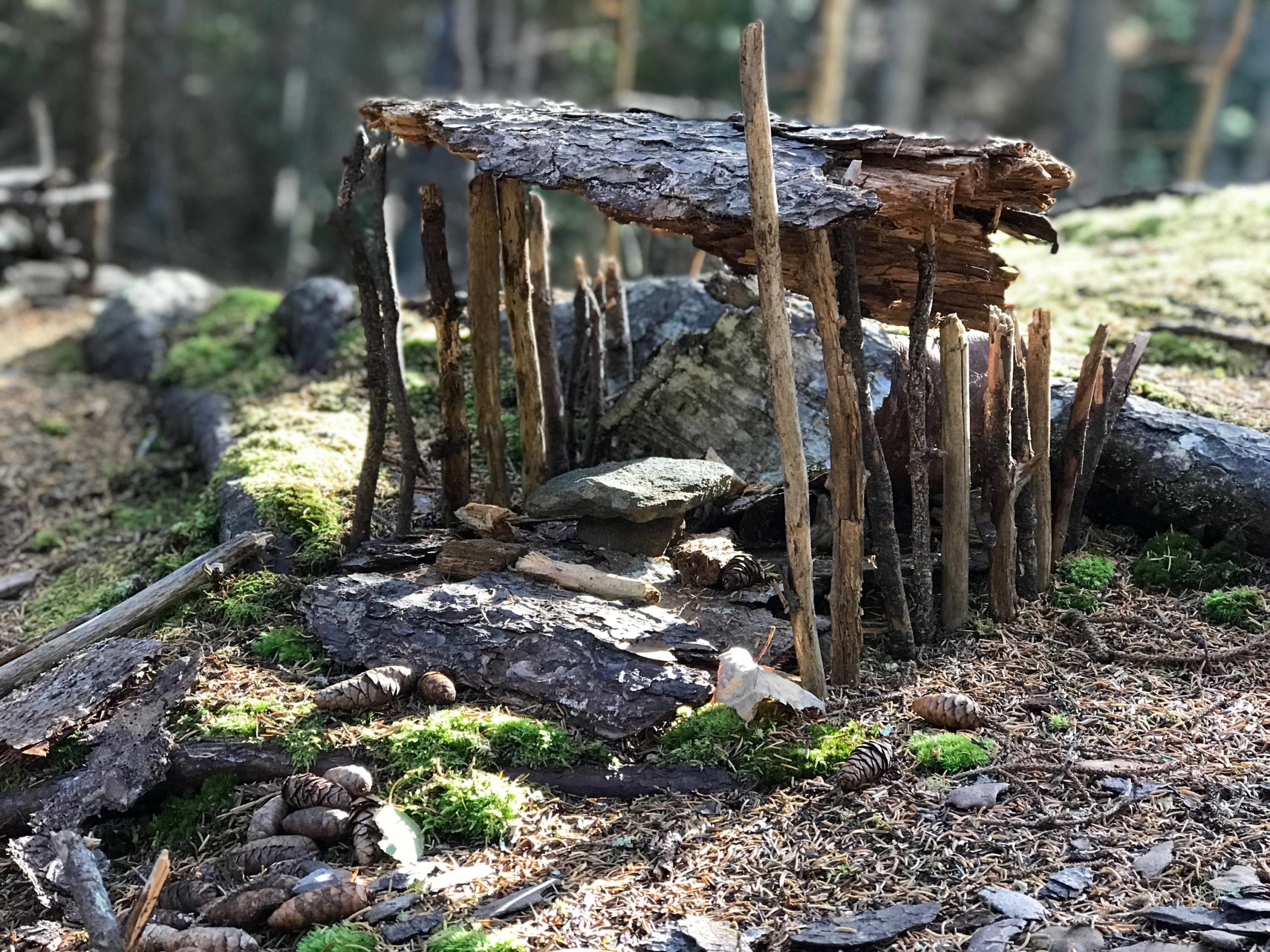
Midday: I find a refuge from the wind on the Backside, where I sit on the rocks below Whitehead, painting for about three hours before the wind finds me again. It is as if it took it personally that I had managed to slip away. My easel blows over, and my palette and water jar spill, so I decide to call the painting done. Besides, there is the rest of the Backside to explore.
The trail around the north end of the island only runs a few miles, a mere jaunt by mainland standards, but it turns out to be rough going, and I lose my way many times. I have to scramble up granite walls and push through dense brush to find it again. In some places, the trail narrows to an animal track and climbs up along an exposed rocky face, so care is required. I imagine my experience must be akin to that of the early islanders who settled here.
Evening: My phone pings, and I receive a text as I walk into the village — so much for my silly 17th-century comparisons. It is Alison, telling me she has gone in-shore and won’t be back until after I leave. I haven’t seen a soul all day.
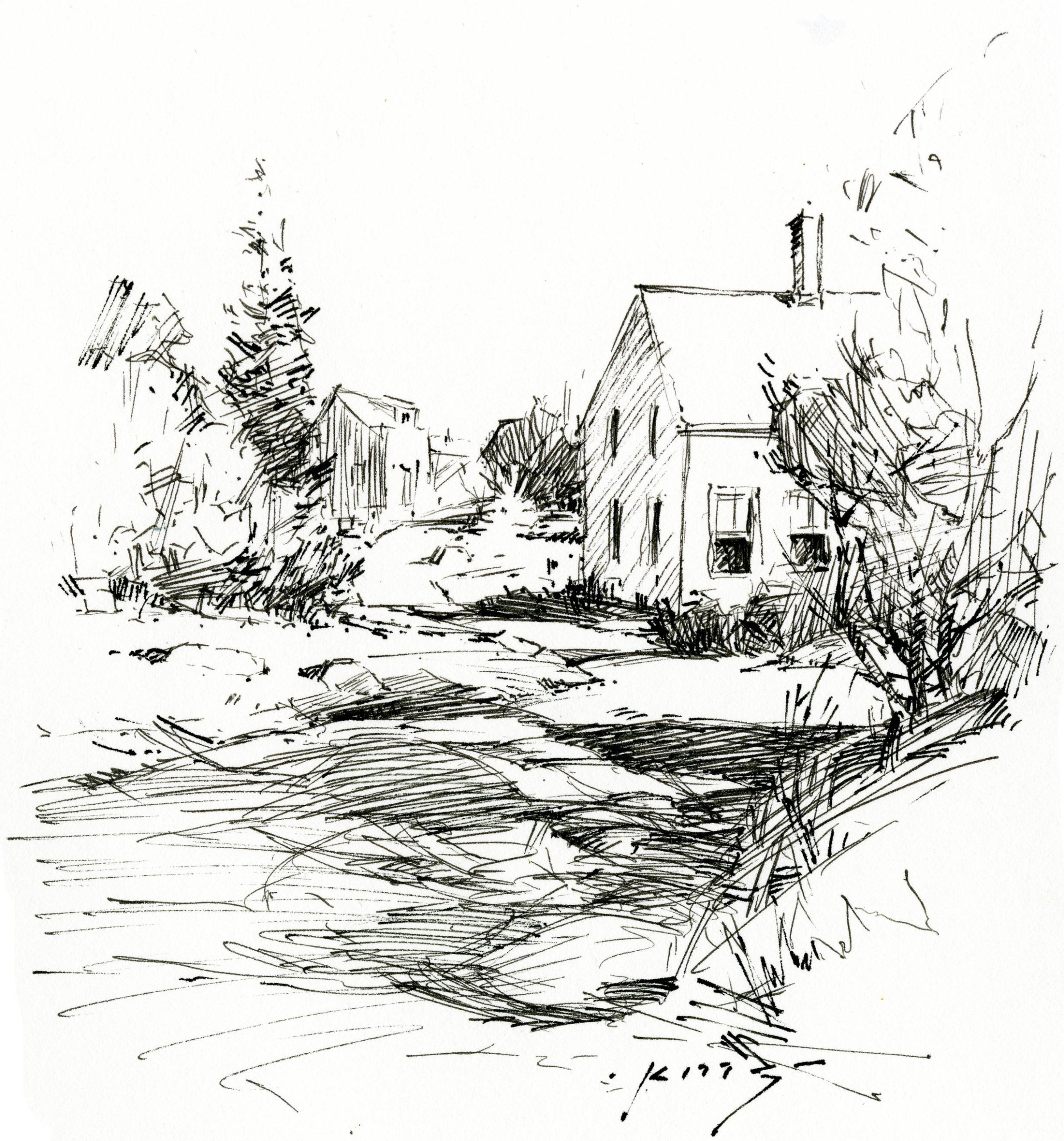
FRIDAY DEPARTURE — HEAVY STREAKS OF CLOUDS, CLEARING EXPECTED
Morning: I leave Monhegan today, so I’ll pack first and then sketch down by the dock until the ferry arrives. Texas awaits, and I must be there by tomorrow. It’s my last plein air event of the season, which means a shift back to painting with purpose. Being mercenary isn’t all bad. These competitions and events provide fantastic opportunities for me and my like-minded peers. They make us work harder and introduce us to new collectors, plus the friendly competition pushes us all to excellence. Having said that, my time here on Monhegan has been restorative and will remain so for a long while. I have been reminded of the joy of simply throwing my gear on my back, heading out the door, and plein air painting without intent.
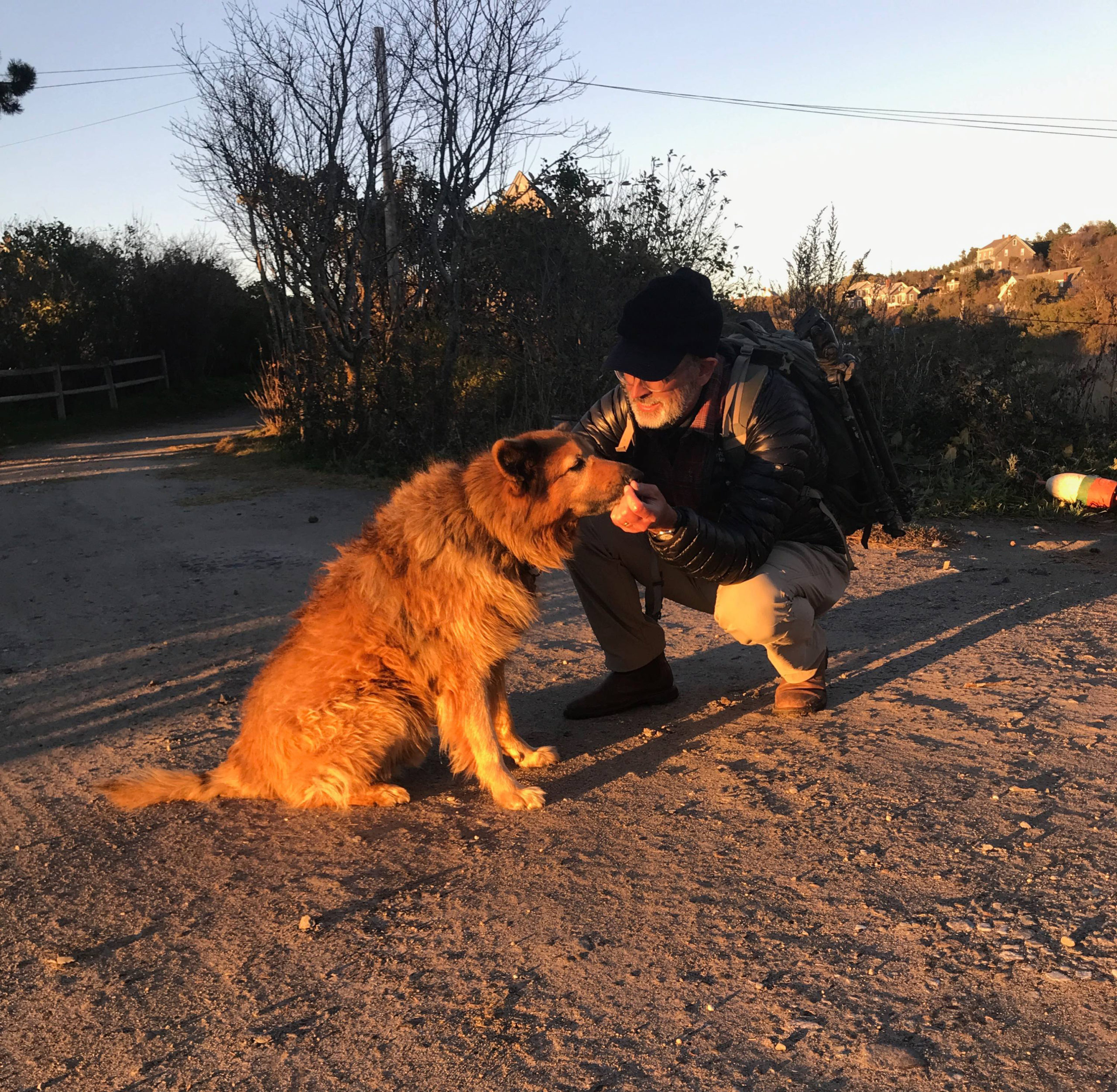
Related: Listen to Plein Air Podcast: Episode 16 – Eric Rhoads with Thomas Jefferson Kitts (click here to listen)
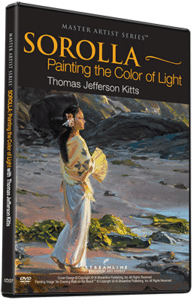 My video, “Sorolla: Painting the Color of Light,” extensively covers the concept of painting the temperature of light. In truth, I began working on this video five years ago when I began traveling to view Sorolla’s masterworks and the places he painted. My demonstration is a stroke-by-stroke, fifteen-hour presentation, with some extras. It includes many detailed explanations of what I am about to do, and more information as I do it.
My video, “Sorolla: Painting the Color of Light,” extensively covers the concept of painting the temperature of light. In truth, I began working on this video five years ago when I began traveling to view Sorolla’s masterworks and the places he painted. My demonstration is a stroke-by-stroke, fifteen-hour presentation, with some extras. It includes many detailed explanations of what I am about to do, and more information as I do it.
Nothing is left out or held back and nothing is dumbed down. Additional topics beyond color temperature are presented in detail. I discuss how Sorolla applied his paint in his mature years; how he altered, edited, and simplified his subjects; how he used his brush at the start of a painting; how he used it at the end; and so much more.
If, like me, you are in awe of Sorolla — or if Sorolla is a new artist to you — you can learn a lot about how he painted from my demonstration. Whether an experienced painter or someone new to the world of painting, you can learn how to see and manipulate color temperature to add vibrancy and life to your own work. [Order here]

